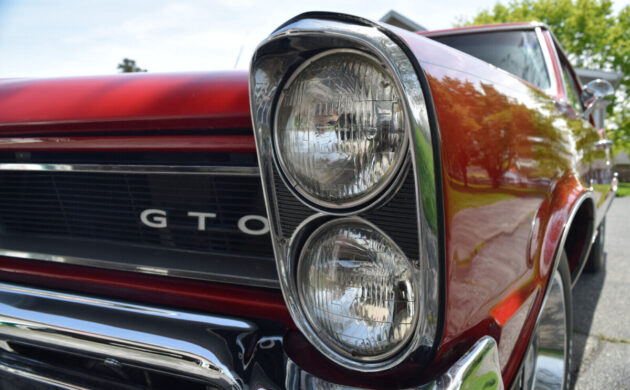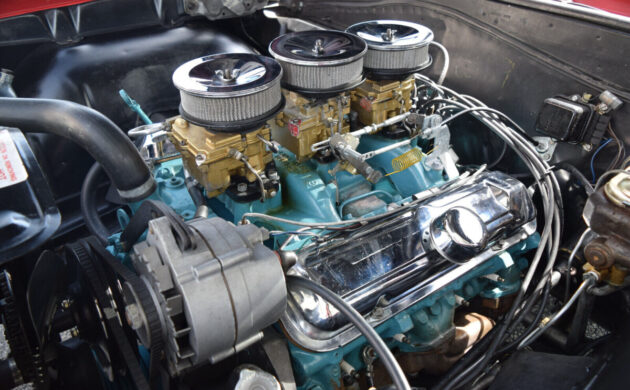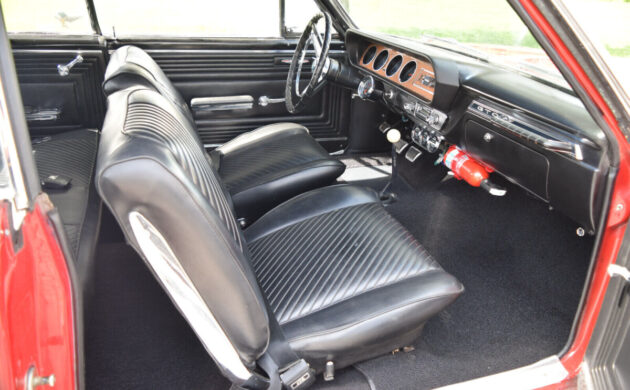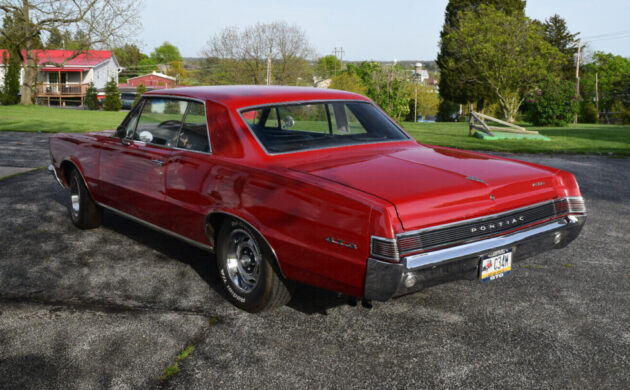Gran Turismo Omologato is an Italian phrase that basically means a factory-built race car. The “GTO” nameplate wasn’t unique to Pontiac, but it may be the most recognized usage. The Pontiac GTO was introduced in 1964 and is considered to be one of the first true muscle cars. This one is from 1965 and can be found here on eBay with a current bid of nearly $30,000. Located in Leesburg, Virginia, this one looks like a nice driver-quality example that anyone would be proud to own. Take a closer look at this beauty.
Stacked headlights were a style change for the GTO in 1965. The 1964 model was based off of the LeMans and in 1965 it moved to the Tempest.
The iconic Pontiac engine color adornes the 421 cubic inch tri-power V8. The engine starts with a WJ block that is dated January 2, 1965. The engine houses 10.5:1 compression thanks to Keith Black pistons. Other internals include Eagle rods, Ohio crank and a cam from Comp. The power is sent through a Muncie M20 4-speed with new u-joints and a 10-bolt rear end. Sounds like a pretty bullet proof setup to me.
The seller says the seats have been recovered with new foam underneath. The dash cluster and clock were replaced in 2006 along with a new dash wiring harness, glove box switch, and backup light harness in 2009.
As stated before, this looks like a nice driver-quality car that anyone would be proud to own. The drivetrain makes the car a little bit of a sleeper (although I’m not sure how much of a sleeper a bright red GTO can be). What do you think of this Goat?







Car looks great, but the head gaskets are gone which I find a bit strange. Spent a boat load of bucks putting this together and used cheap gaskets or something is not right with the block or heads. May not be a simple fix, look at the redline set on that tach. Run a Poncho that hard better tie a basket underneath. Had a few, just saying. Would definitely be worth looking into before laying out some money for the transportation.
How (pray tell) can you know the head gaskets are gone?
There is an old saying
About blowing someone else’s candle out so yours looks brighter.
Interesting comment!
I stand corrected!
I finally got to the add & red the description
Interesting
IF you could get it for 33000.00 it would be worth putting some money and time in that power plant, even if you had to spend 8000.00 on it.
GTO and sleeper, isn’t that called a oxymoron
Head gaskets could of… Been the wrong type and leaked.. over heated the engine causing the head gaskets to fail. hope they didn’t warped the cylinder heads. Otherwise this is a cool GTO. Good luck to the next owner.🇺🇸🐻🇺🇸
Hopefully this is an easy fix for the next owner, nice car to start with! The 15″ Rally l’s are perfect. It’s a shame someone hasn’t reproduced these in aluminum as they did with the Rally ll’s Aftermarket Hurst shifter, and I would have fabbed up a bracket to mount the fire extinguisher between the seats, super easy access and not grabbing your attention like it does under the dash.
may have to mill the heads no biggie over here in NY we got good shops.
looks excellent but would have to check out the head situation to be sure….
If this has bad head gaskets, is there a chance that coolant got into the cylinders? The car looks good but I’d expect the worst and plan on a full rebuild on the engine.
I can’t complain about how this one physically looks, but personally I’d prefer a 66.
Is this one the ” Royal ” pkg ? With the higher compression , that winds out more.
The Royal Bobcat package was essentially thinner head gaskets, locking rocker arm adjusting nuts, a distributor recurve kit with Mallory points and condenser, blocked heat riser intake gaskets, a carb re-jetting kit. These could be dealer installed, or available as a kit over the counter. Royal Pontiac could also prep your car as a NHRA class legal race car. These days, Royal stickers are on more GTO’s than ever built! Still a cool history.
Thanks for the info 65
I seem to recall the 3-2’s were a dealer added option, so almost all had them by the late 60’s.
We all know the motor for GOAT in 1965 was the 389, so did I miss something? The 421 HO was more than a bored out 389.
For model year 1965, 3×2 carburetion (a/k/a “tri-power”) was factory option RPO L71 for an additional $115.78. Along with this option’s included “068” camshaft, horsepower was rated at 360. (The standard 4-bbl engine with the “067” cam was rated at 335 HP)
The Tri-Power was a factory option, however, dealer installed setups were fairly common.
Thank you, do you know with the factory option if it was identified in the VIN or the tank plate?
Oh, do you know how many early Z28’s came with headers, and was there some ID?
Thanks in advance.
BLUE;
On a ’65 GTO, the tri-power option (or the GTO option for that matter) is not identifiable by the VIN or the cowl tag. If one is fortunate to have the Protect-O-Plate or a build sheet, the bingo! The engine code “WS” will appear which signifies this option with a manual transmission (and “YR” for the automatic version). Otherwise, the ONLY other way to determine the factory configuration for a ’65 Pontiac A-body is by running the car’s VIN through Pontiac Historic Services. (PHS)
19sixty5 and 3deuces,
Thank you, you both know stuff, good of you to share. I could not even remember what a Protect-O-Plate was called. I have forgotten more that half of what I once knew, and I never knew that much in the first place. I could drive! And blessed with buddies that could tune all there was to get.
Again, thanks for your cordiality. I can be annoying blunt at times.
You misunderstand GTO. GT is just gran turismo, widely understood to be a long distance touring car (ie has a roof). Omologato means homologated, which is to say that it complies with certain standards. In car terms, this is often for racing ( appendix K, Gp2/3/4 etc) where the standards are applied by a national or international organisation.
It does not mean a factory-built race car per se.
Actually Pontiac didn’t have a small block/ big block program
They had 1 block that was used in their entire line with the exception of the aluminum V8
Boring and stroking is how they got the cubic inches along with necessary internal reinforcing
True about the blocks, if by “necessary internal reinforcing”, you mean; valves, cams, pistons, rods, carbs, heads, etc. then sure.
I know the block was about the only thing that transitioned to the Judge, at least that is what the mechanics told me at the time.
69 Judge
Drag times: 0- 1/4mile (s): 13.8
speed at 1/4mile: 102 mph
65 GTO
Drag times: 0- 1/4mile (s). 14.4
speed at 1/4mile: 158 km/h / 98 mph
.6 seconds is more than bore – stroke
The ’65 was 360 hp
The Judge 370 hp
10 hp will not give you .6 will it? The Judge was close to 400 hp.
Omologato actually means street cat in Italian
Hi Jay. Cambridge.org’s dictionary defines “omologato” as “approved, certified”.
Car and Driver detailed the origin of the term “GTO” in an article about the Pontiac and Ferrari GTOs, available online:
“FIA homologation for the GT class required a production run of at least 100 cars, but Ferrari had no intention of building so many: Il Commendatore maintained that his racer was simply a 250GT Berlinetta (in production since 1959) with a few changes listed on the homologation papers. The competition, principally Jaguar and Aston Martin, fought this stretching of the rules, but the FIA officials recognized the crowd-pulling potential of the new Ferrari and approved it for the 1962 GT class. This ritual is summarized by the three most famous letters ever worn by an automobile: “GTO” stands for “Gran Turismo Omologato,” which, loosely translated from the Italian, means homologated (recognized for competition) grand-touring car.”
We all know the motor for GOAT in 1965 was the 389, so did I miss something? The 421 HO was more than a bored out 389.
In Kentucky, GTO meant “going to Ohio”.
or … Gas, Tires and Oil
or … Girls Take Over (the wife sneaking your GTO out for a spin, per the ’65 GTO television ad)
Go To Olds, Garbage Truck with Options, Got Too Old are others I remember. I have a 65 with trips, love my Goat!
SOLD for $32,100.